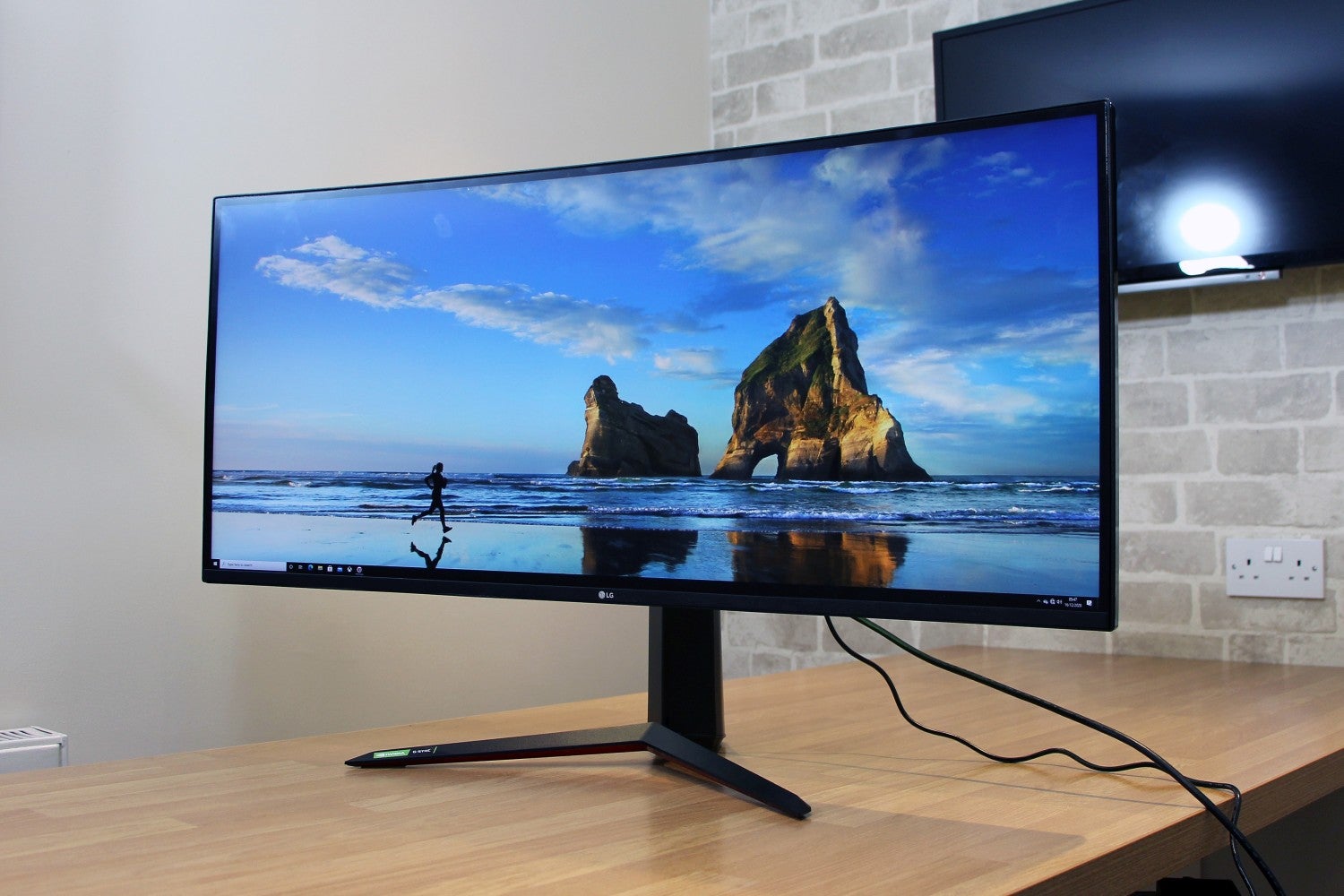Alienware AW3821DW Review
Can this gaming monitor wow with its bright, widescreen design?
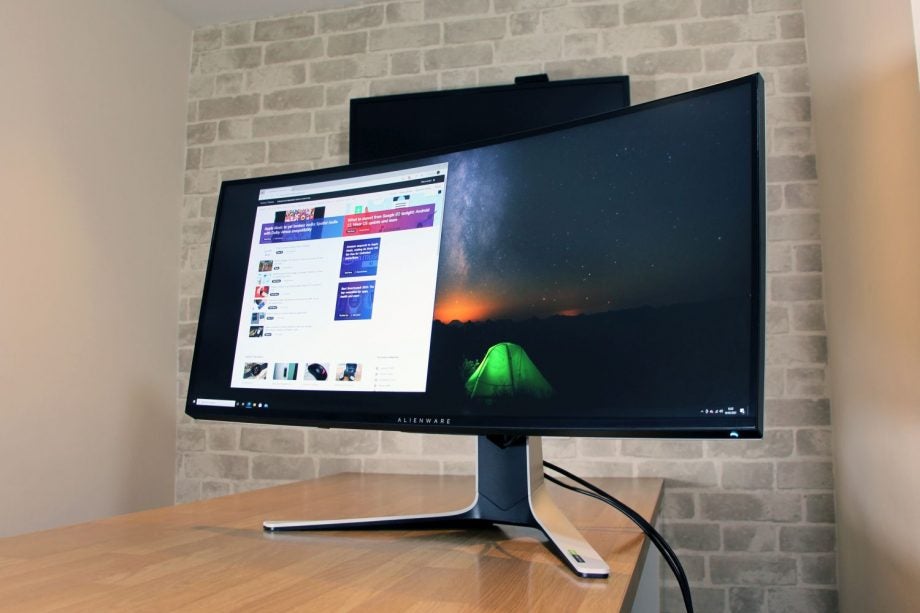
Verdict
The Alienware AW3821DW gaming monitor looks great, offers a solid range of features and it produces bright, breezy imagery that makes games pop. But its lack of great contrast means that it doesn’t display a huge amount of depth, and it’s not very good at HDR. As such, you’ll find more nuance and realism elsewhere.
Pros
- Accurate, bright colours
- Robust and good-looking design
- Great resolution and width
- A solid selection of features
Cons
- Underwhelming contrast
- Unsubtle in HDR mode
- Expensive
Availability
- UKRRP: £1299
- USARRP: $1425
- EuropeRRP: €1399
Key Features
- Display:Large 38-inch 3840 x 1600 display
- Refresh rate:Speedy 144Hz for smooth fast-paced action
- Response timeRapid 1ms response time ensures minimal delay
Introduction
The Alienware AW3821DW is the largest and most expensive monitor sold by Dell’s high-end gaming brand, and that heaps plenty of pressure on this display’s broad shoulders.
This panel fights back with a powerful specification. The 38in widescreen panel has a huge resolution of 3840 x 1600, and it combines that with eye-catching Alienware design and Nvidia G-Sync support.
Price and availability
The Alienware AW3821DW isn’t cheap. In the UK, you’ll have to fork out £1299, and in the US it will set you back $1425. In Europe, it costs €1399.
If you want this sort of hardware in a smaller design, then Alienware also produces the AW3420DW. It’s another 21:9 panel with a slightly smaller resolution of 3440 x 1440, and it costs £900 / $1139 / €999 – not cheap, but more manageable than the 38in model reviewed here.
The Alienware’s most significant rival right now is the LG UltraGear 38GN950. Both 38in displays share the majority of key attributes, but the LG is surprisingly more expensive than the Alienware – it costs £1498 / $1799 / €1799.
Design and features
- A good-looking, sturdy and impressive exterior
- A broad range of adjustability options and features
- The size, resolution and curve are immersive and well balanced
The AW3821DW pairs its 38in diagonal with an aspect ratio of 21:9 and a resolution of 3840 x 1600. That’s a superb starting point for immersive gaming: the same number of horizontal pixels as a 4K panel means plenty of room for games to spread out. I like that vertical figure, too: it’s more pixels than the 32:9 widescreens that are popular right now, and more than 1080p and 1440p displays. It means games won’t feel cramped, which is a common pitfall on other widescreens.
You’ll only want to look towards 32:9 panels if you play racing games, where extra width is beneficial, and you’ll only get a crisper display with a 4K monitor.
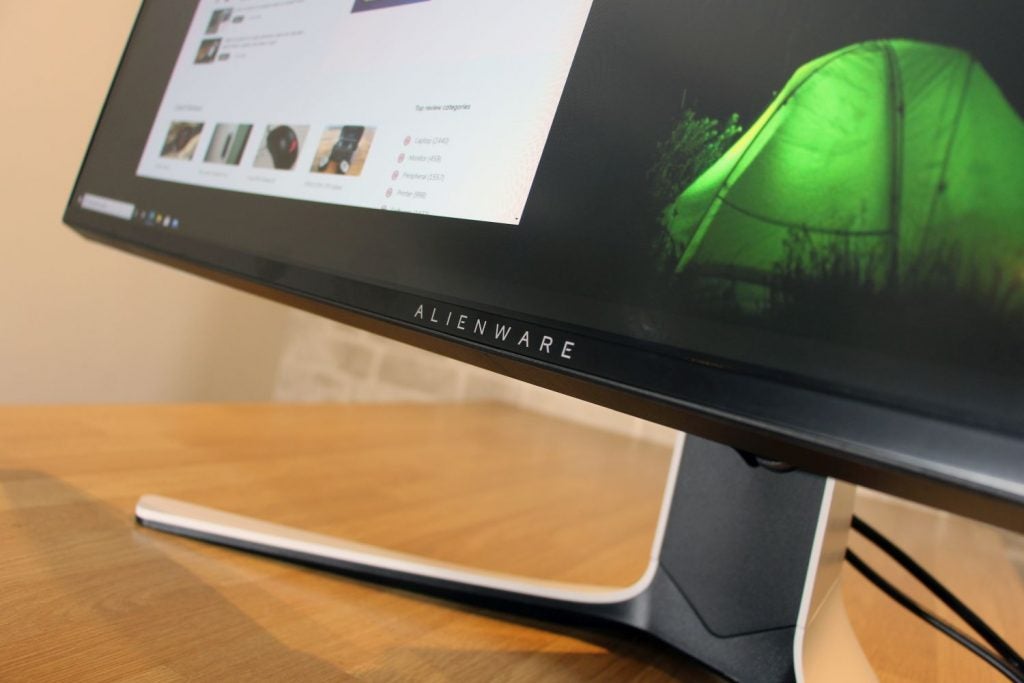
The only other big downside to the Alienware’s resolution is the requirement for a hefty graphics card, such as an Nvidia GeForce RTX 3070 or AMD Radeon RX 6700 XT, and something more powerful wouldn’t go amiss. This display isn’t quite as demanding as a 4K panel or the biggest 32:9 displays, but it isn’t far off.
The Alienware has a 2300R curve, which is subtle – sometimes, it’s hard to notice at all. It’s the same radius as the LG, and it makes the sides and corners easier to see. However, it’s a slight radius by modern standards, and screens with designs between 1000R and 1800R are arguably more immersive.
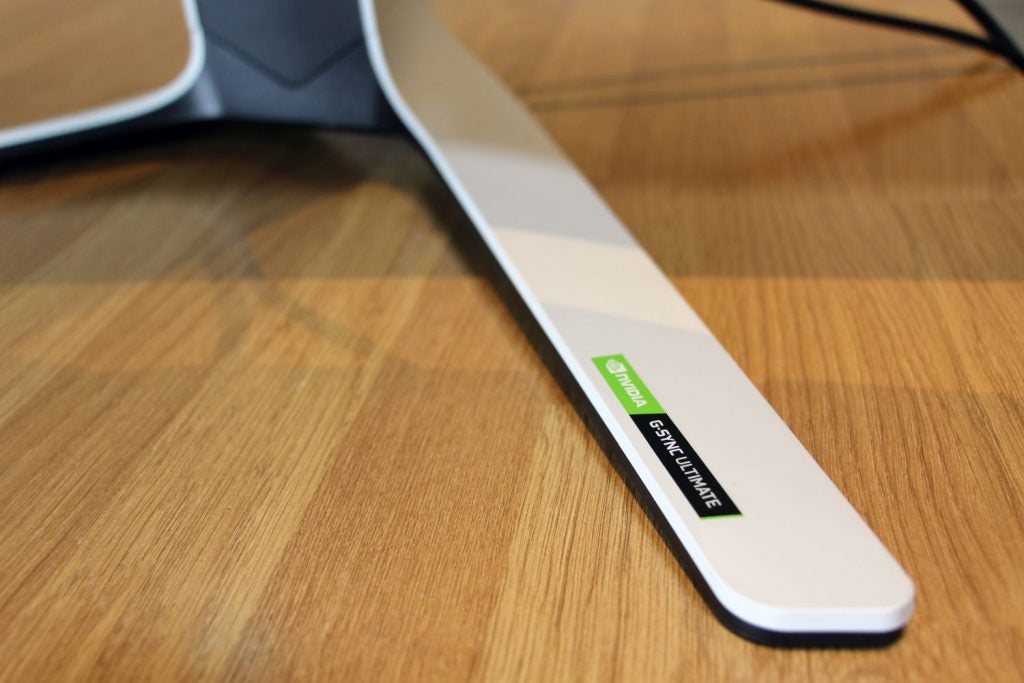
The underlying panel is an IPS display that supports 10-bit colour, and it offers a 1ms response time. It supports Nvidia G-Sync Ultimate at 144Hz, and it’s compatible with AMD FreeSync over DisplayPort.
You’ll only be able to use 10-bit colour if you drop this display down to a refresh rate of 120Hz or below, but that’s not a big deal – the difference isn’t noticeable in gaming, so running at 8-bit and 144Hz is the better option. If you use HDMI, this display peaks at 85Hz unless you lower the resolution.
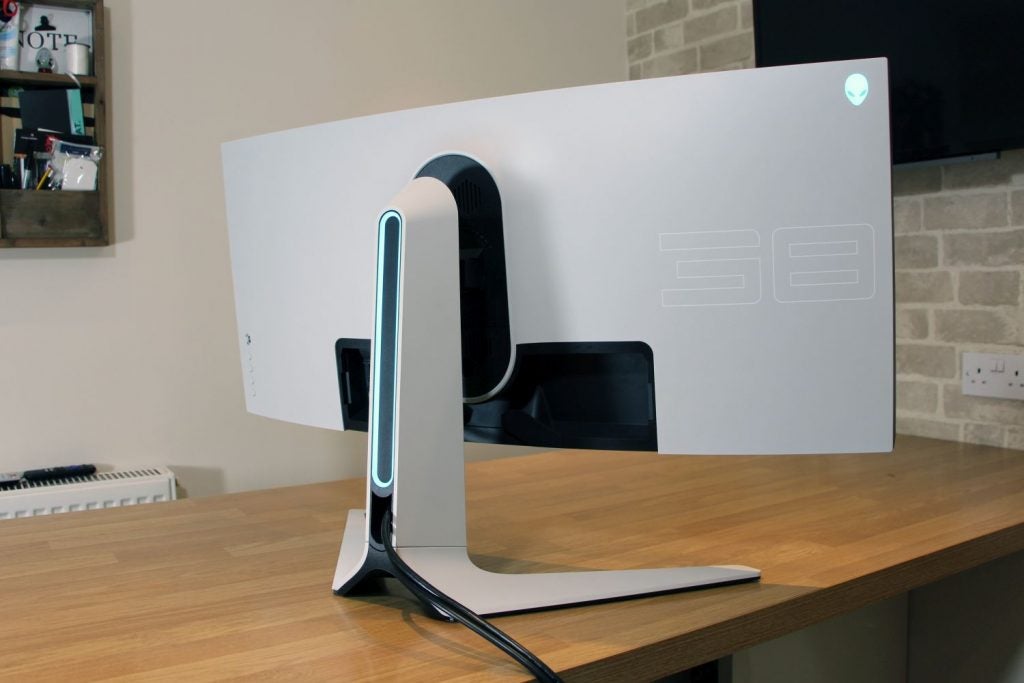
Also bear in mind that the less-than-4K vertical resolution and the reliance on HDMI 2.0 rather than HDMI 2.1 means that the Alienware isn’t suitable for use with the next-gen consoles such as the PS5 and Xbox Series X.
Once I’d placed this big beast next to my gaming PC, though, it really did look the part. It’s built from good-looking black and white plastic, and there are customisable RGB LEDs on the rear of the stand, in the logo, and beneath the bottom bezel. Build quality is superb, with no movement and hardly any wobbling – but bear in mind that the AW3821DW is neither small nor light: its 11.5kg weight is significant, and it’s 300mm deep, so you’ll need plenty of desk space.
Beneath the bezel, you’ll find two USB 3.2 Gen 1 ports, and there are two more around the rear. One port serves up fast-charging ability, and there’s a USB upstream port so you can connect to a PC and run peripherals through the display. The Alienware has a cable management cavity in the stand, a couple of audio jacks, and an on-screen display with a solid range of options and quick, easy navigation – alongside a snappy and responsive joystick on the rear.
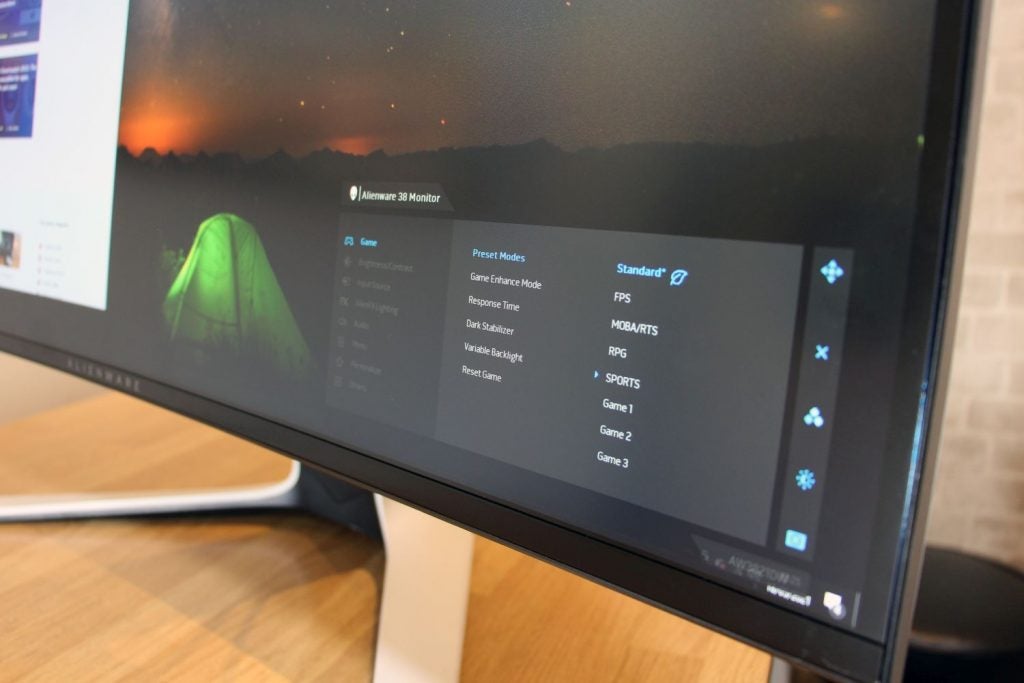
The Alienware relies on a snapping stand mechanism and one tool-free screw in the base, so it’s very easy to build. It also offers 130mm of height adjustment, ample swivel and tilt movement, and 100mm VESA mounting support. That’s about as much adjustment as you’ll get from any widescreen.
This well-built monitor is easy to live with – outside of its large dimensions – although there are a couple of missing features. A USB-C port would have been welcome here, and there are no speakers.
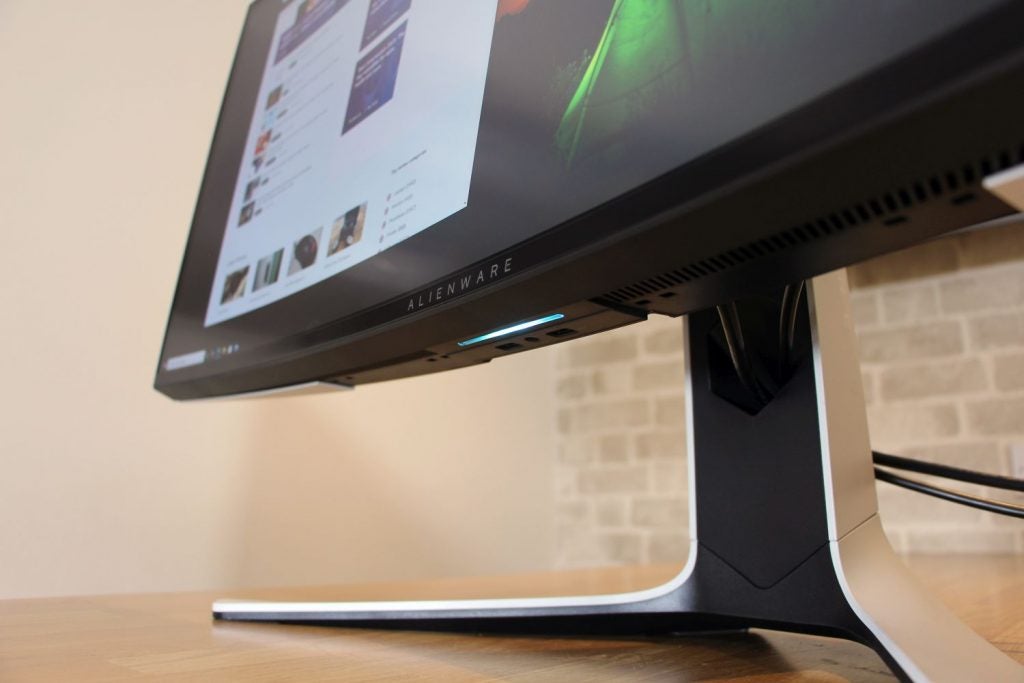
The rival LG shares many of these attributes. That monitor is also an IPS display with the same resolution, curve, and 1ms response time, and it has the same issues with switching between 10-bit and 8-bit colour. The LG supports AMD FreeSync natively, but it’s also Nvidia G-Sync certified.
LG’s display is lighter than the Alienware, but it offers fewer adjustment options than the Alienware, and it has no USB ports.
Image quality
- It’s smooth and sharp when rendering mainstream games
- Reasonable colour accuracy in SDR modes
- Mediocre contrast and a lack of HDR ability mean this display lacks depth
The Alienware AW3821DW delivers smooth, sharp gaming, and the 144Hz refresh rate is high enough to handle single-player games and mainstream eSports titles. You’ll only want a 240Hz or 360Hz display if you’re serious about high-level competition, and those monitors have smaller resolutions.
The synchronised 144Hz refresh rate delivers butter-smooth gaming in the biggest titles, and its response time performance was impressive – and it’s also possible to deploy the Fast overdrive mode without suffering ghosting. The display’s input lag sits way below 10ms, too, which is excellent.
I used a colorimeter to measure the Alienware’s performance out of the box, and it delivered reasonable colour accuracy. Its Delta E of 1.93 is great, and its colour temperature of 6851K is on the cool side but isn’t wayward enough to cause problems. The AW3821DW rendered 99.5% of the sRGB gamut at a stonking 131.6% volume, and it displayed the HDR-friendly DCI-P3 gamut with figures of 92.8% and 93.2%.
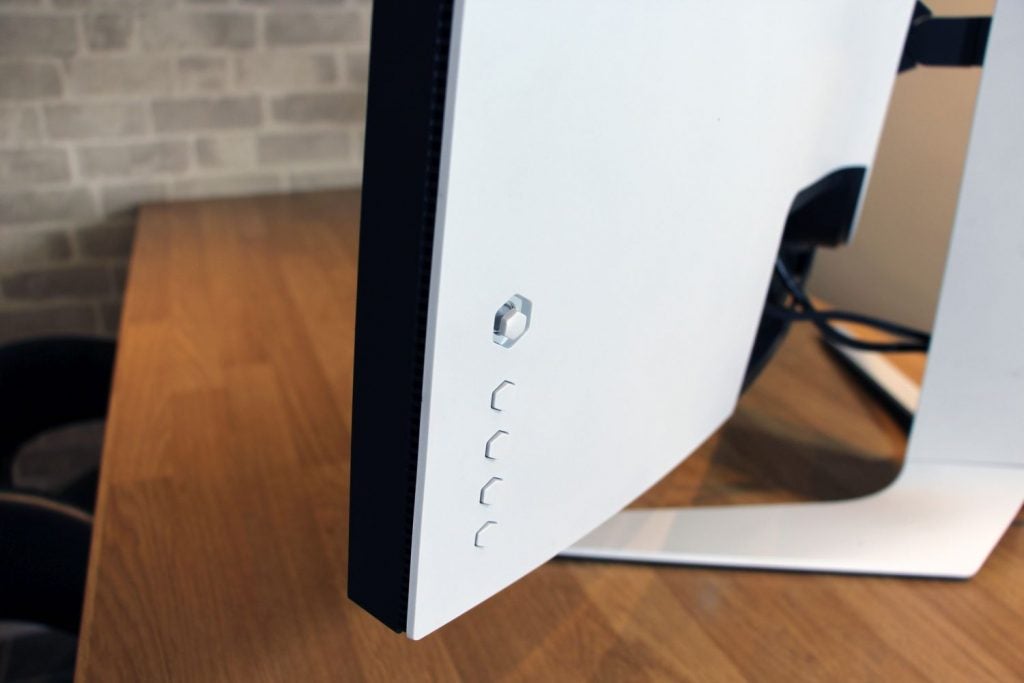
This display is uniform. In most screen segments, its backlight only deviated by less than 5%, which is great for a widescreen monitor. In the top-left corner the backlight declined by 16%, but that’s the only sector where the display had issues, and it isn’t a big deal.
The default brightness level of 225 nits is fine, but it’s paired with a black point of 0.26 nits, and that’s too high. The resulting contrast ratio of 865:1 is mediocre for an IPS panel, and it means the Alienware lacks nuance. In particular, black shades are weak and often look grey.
The peak SDR brightness level sits at just under 500 nits, but at this level the contrast didn’t improve – and, similarly, things stayed a little washed-out and underwhelming with the brightness reduced to a more sensible everyday level.
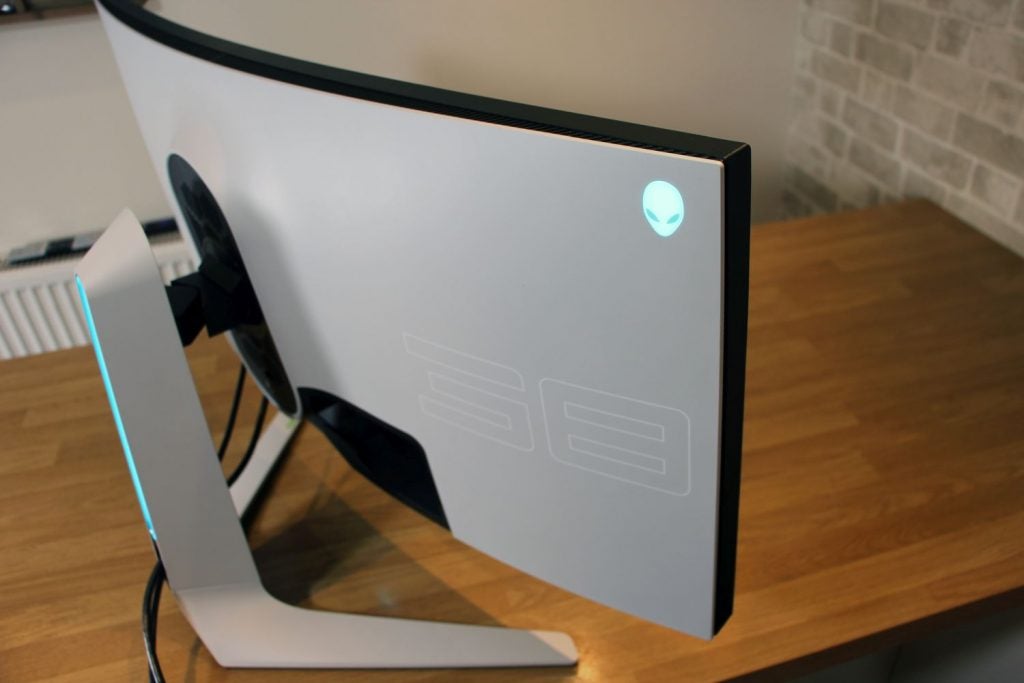
The Alienware isn’t a particularly good HDR option either, despite its VESA DisplayHDR 600 certification. The black level does decline by a reasonable amount in HDR mode, and the brightness does improve to around 700 nits, but the Alienware only has a handful of edge-lit dimming zones. You can see an improvement to HDR content on this display – it’s certainly punchier – but it’s never subtle, and it rarely looks uniform.
Don’t rely on the FPS, RTS, RPG, and Sport modes, either. None of them improved the contrast ratio beyond the screen’s initial result, and they all made the panel’s Delta E worse. This display also can’t handle the Adobe RGB colour space – only capable of a mediocre 80.1% coverage level.
The rival LG screen adheres to the VESA DisplayHDR 600 colour gamut, too, and is also disappointing in HDR content – so neither panel excels in this regard. The LG does defeat the Alienware in key SDR areas, though: it displays better contrast and more accurate colours.
Conclusion
The Alienware AW3821DW looks fantastic, it’s sturdy and versatile, and it offers more features than its rival from LG. And when it comes to gaming, it’s certainly serviceable – the size and resolution are immersive, it’s smooth and sharp, and it produces bright, punchy images.
However, it doesn’t have the depth required to make games truly look their best, and it isn’t a great HDR option. The pricier LG is better here, although that display suffers from a relative dearth of features.
If you want a good-looking gaming widescreen with bright colour reproduction and plenty of features then the Alienware is worthwhile, but there are more suitable alternatives if you’d prefer more depth and realism in your imagery. Check out our Best Gaming Monitor list for more options.
Best Offers
Should you buy it?
You want a good-looking, bright and feature-packed display
The Alienware AW3821DW nails the basics with a bright picture and oodles of features. The 144Hz refresh rate makes it good for both single-player and multiplayer games too.
You’re searching for realistic colours, lots of depth and great HDR performance
While the AW3821DW is a great gaming monitor, its colour accuracy falls short for it to double up as a creator-focused panel. You’re also best off looking elsewhere if you want a top-notch HDR performance.
Verdict
The Alienware AW3821DW gaming monitor looks great, offers a solid range of features and it produces bright, breezy imagery that makes games pop. But its lack of great contrast means that it doesn’t display a huge amount of depth, and it’s not very good at HDR. As such, you’ll find more nuance and realism elsewhere.
FAQs
The Alienware is covered by a three-year warranty, which is one more year than is offered by the rival LG display.
The Alienware comes with 130mm of height adjustment, 40 degrees of swivel and 26 degrees of tilt, which is entirely normal for this class of display.

